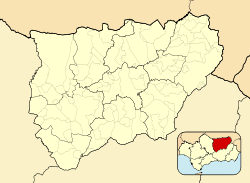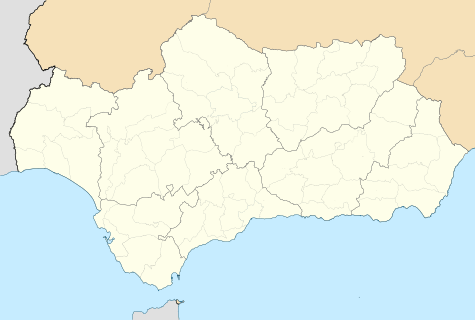Linares, Jaén
Linares (Spanish pronunciation: [liˈnaɾes]) is a city located in the Andalusian province of Jaén, Spain. It is considered the second most important city in that province and had a population of 62,347 in the most recent census. The altitude is 419 metres (1,375 feet) and the total area of the municipality is 195.15 square kilometres (75.35 sq mi). It is located on kilometer 120 on the Valencia-Córdoba highway (N-322) and is 51 kilometres (32 miles) from the capital, Jaén.[2]
Linares | |
|---|---|
City | |
.jpg) Marquis of Linares Hospital | |
 Flag .svg.png) Coat of arms | |
 Linares Location in Spain  Linares Linares (Andalusia)  Linares Linares (Spain) | |
| Coordinates: 38°05′N 3°38′W | |
| Country | |
| Autonomous Community | |
| Province | |
| Comarca | Sierra Morena |
| Government | |
| • Type | Mayor–council |
| • Body | Ayuntamiento de Linares |
| • Mayor | Juan Fernández Gutiérrez (PSOE) |
| Area | |
| • Total | 197.5 km2 (76.3 sq mi) |
| Elevation (AMSL) | 419 m (1,375 ft) |
| Population (2018)[1] | |
| • Total | 57,811 |
| • Density | 290/km2 (760/sq mi) |
| Time zone | UTC+1 (CET) |
| • Summer (DST) | UTC+2 (CEST) |
| Postal code | 23700 |
| Area code(s) | +34 (Spain) + (Jaén) |
| Website | www.ciudaddelinares.es |
.jpg)
Overview
The city is well connected to the rest of Spain. The Autovia de Andalucia, NIV Madrid-Cádiz, is located 12 km (7 miles) to the west at Bailén. There is a railroad station at Linares-Baeza, with lines connecting Madrid and Cádiz, and Madrid-Granada-Almería.
Near to Linares is the ancient town of Castulo, which dates to antiquity and earned much of its revenue from the lead mines located there. It was at Castulo that Carthaginian general Hannibal married the local Iberian princess Himilce on the eve of the Second Punic War.
The Linares Advanced Technical College is located in Alfonso X "the Wise" Street and offers a wide range of engineering studies, belonging to the University of Jaén since 1 July 1993. The Scientific-Technological Campus is still under construction.
Linares is also the place where the annual Linares chess tournament was held.
History
Around the middle of the nineteenth century Linares became an important mining center with lead mines nearby. The smelting of lead, the manufacture of lead sheets and pipes, and the production of by-product silver from the lead ores led to a significant population increase. The 6,000 inhabitants in 1849 became 36,000 in 1877. This commercial and industrial growth brought the concession of the title of city in 1875.
Economy
The lead mines of Linares were in almost interrupted activity from pre-Roman times until the 1990s.[3] There were also lead smelters and gunpowder, dynamite and rope factories as auxiliary to the mining industry. Currently, the mines of Linares are protected as cultural heritage.
Santana Motor, the former producer of all-terrain vehicles for the Spanish Army which was recently shut down due to the economic recession. There is also a factory producing trains (CAF), another one producing components for wind turbines (Grupo Daniel Alonso y Gamesa), and a beet sugar plant (Azucareras Reunidas de Jaen S.A.), which now produces biodiesel from colza oil, palm oil, soybeans, and sunflower oil.
Personalities
The bull ring in Linares is famous for the death in 1947 of bullfighter Manolete (Manuel Rodríguez Sánchez). On 28 August every year, people place flowers on his statue in Linares. Manolete's death is remembered in the ring by putting a bunch of roses in the place where he fell.
Linares is the birthplace of classical guitarist Andrés Segovia, singer Raphael and the hometown of jazz vocalist Virginia Maestro and Blessed Manuel Lozano Garrido, who was beatified on Saturday 12 June 2010 in Linares.
International relations
Notes and references
- Municipal Register of Spain 2018. National Statistics Institute.
- Linares : Situación
- Miguel Calvo Rebollar (1928). Minerales y Minas de España, Vol.2 Sulfuros y sulfosales (hardcover) (1st ed.). Vitoria, Alava (Spain): Museo de Ciencias Naturales de Alava. pp. 293–301.
External links
| Wikimedia Commons has media related to Linares. |